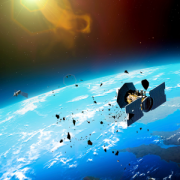Efforts to develop spacecraft and other technology capable of capturing and deorbiting space debris are crucial for ensuring that Earth’s orbital environment remains functional, safe, and sustainable for future space missions. Much like ocean cleanup initiatives for removing plastic waste to protect marine ecosystems, space debris removal aims to mitigate the growing risks posed by dead satellites, spent rocket stages, and other components and fragments left behind from decades of space activity.
Although the problem of space debris has been acknowledged for decades, progress toward meaningful solutions has been slow. Current mitigation policies remain inadequate, and spacecraft or technologies designed for debris removal are still largely in the experimental and testing phases. That said, efforts are beginning to accelerate.
Why Space Debris Removal Matters
Space debris removal is important for sustainable space operations and has serious implications for life on Earth as well. This includes:
- Collision prevention. There are approximately 35,000 tracked objects in Earth’s orbit, with millions more untracked fragments. These objects pose a serious risk to operational satellites and crewed missions; even small pieces of debris traveling at high velocities (i.e., approximately 17,500 mph/~28,000 kph) in low Earth orbit (LEO) can cause catastrophic damage to satellites and other spacecraft.
- Preserving orbital access. Without intervention, the accumulation of space debris could lead to a scenario known as the “Kessler syndrome” where cascading collisions generate more and more debris, making certain orbital regions so dangerously congested that some areas of space eventually become unusable for satellites, space stations, or future missions.
- Protecting Earth-based services. Many critical services — such as weather forecasting, GPS navigation, maritime shipping, and global communications — are highly dependent on satellites, as are some agriculture and forestry services (e.g., precision farming, wildfire detection). Space debris collisions threaten these infrastructures, with the potential to seriously disrupt daily life on our planet.
- Protecting Earth and its ecosystems. Abandoned rocket boosters, defunct satellites, and other spacecraft parts pose a threat to life and property on Earth should they lose orbit and crash into the planet. The pollution factor must be considered, too — including the possible impact of debris on forests, oceans, and wetlands.
Key Developments in Space Debris Removal
Key developments in space debris removal and mitigation include growing global advocacy, technological advances, evolving international policies and guidelines, and emerging tools and incentives to encourage responsible behavior.
Growing Recognition & Advocacy
Just as environmentalists champion ocean conservation, national space agencies, private companies, and the broader space community increasingly acknowledge the need for stronger orbital stewardship — and are actively developing solutions.
Advances in Debris Capture Technologies
Companies like Astroscale have developed and successfully demonstrated spacecraft capable of maneuvering close to space debris, capturing it, and preparing it for controlled deorbiting. Astroscale has partnered with the Japan Aerospace Exploration Agency (JAXA). On 30 November 2024, Astroscale’s ADRAS-J spacecraft successfully maneuvered to within approximately 15 meters (~49 feet) of a large piece of space debris — a rocket upper stage — orbiting the Earth. The company plans to capture this booster in a future mission.
Other space agencies, including the European Space Agency (ESA) and NASA, are working with commercial partners to develop active debris removal technologies. For example, the ESA’s ClearSpace-1 initiative plans to use robotic arms to grab and deorbit defunct satellites.
Laser-based debris removal systems are also in development. This includes satellites equipped with lasers to vaporize debris fragments, reducing their size and impact risk.
Evolving International Guidelines
Organizations are establishing international guidelines and best practices for debris management. For example, the United Nations (UN) Committee on the Peaceful Uses of Outer Space (COPUOS) Space Debris Mitigation policy efforts include voluntary guidelines urging space actors to minimize debris during space operations, avoid intentional destruction, and ensure post-mission disposal of spacecraft components.
The Inter-Agency Space Debris Coordination Committee (IADC) is a global forum of space agencies that has developed widely recognized Space Debris Mitigation Guidelines to promote responsible behavior in orbit. These best practices include limiting debris released during normal operations, minimizing the risk of on-orbit breakups, ensuring post-mission disposal, and preventing collisions. While nonbinding, the guidelines serve as a technical foundation for national policies and international cooperation on orbital sustainability.
Space Sustainability Rating (SSR)
Developed by the World Economic Forum, the Massachusetts Institute of Technology (MIT), ESA, and others, the SSR system scores space operators on their debris-mitigation efforts. The system evaluates missions across more than 65 parameters — from design and deployment to end-of-life disposal. Operators receive a rating that reflects their mission’s impact on the orbital environment, along with actionable recommendations to improve sustainability. The goal is to encourage transparency and accountability and, by incentivizing responsible behavior, reduce space debris risks and foster a culture of long-term orbital stewardship.
Challenges to Implementing Space Debris Removal & Mitigation
Despite mounting recognition of the orbital debris threat and growing interest in sustainability-focused solutions, the road to effective space debris removal faces institutional, technical, and geopolitical obstacles. Some of the most pressing challenges include:
- Nonbinding nature of guidelines. International norms for space debris mitigation — like those issued by the UN and the IADC — are largely voluntary. Consequently, implementation varies widely, particularly among emerging spacefaring nations and commercial actors. And the absence of enforcement mechanisms can undermine consistent compliance and accountability.
- Commercial proliferation. The rapid expansion of commercial space activities, especially the deployment of large-scale satellite constellations, has outpaced regulatory frameworks. With a growing number of private operators in orbit, coordinating standards for responsible behavior is becoming increasingly more complex. This proliferation increases collision risks and places additional strain on already limited space traffic management infrastructure.
- Lack of active remediation mandates. Most existing policies focus on debris mitigation (i.e., minimizing the creation of new debris) rather than on active remediation of existing debris objects. This results in a regulatory gap for technologies explicitly designed to deorbit nonfunctional objects.
- Dual-use dilemmas and security issues. Many space debris removal technologies, such as robotic arms, maneuverable spacecraft, and laser systems, have clear dual-use potential — applicable to both civil and military operations. This overlap raises national security concerns and complicates collaboration, as some states may view debris removal systems as veiled anti-satellite weapons. Transparency, verification, and trust-building measures are still underdeveloped in this domain.
Conclusion
Efforts to capture and deorbit space debris are essential to preserving the functionality, safety, and sustainability of Earth’s orbital environment. Much like ocean cleanup initiatives, space debris removal efforts seek to address a legacy of neglect, in effect, aiming to reduce the risks posed by dead satellites, spent rocket stages, and countless fragments accumulated over decades.
While the issue has been recognized for years, progress has been uneven. Mitigation policies remain inadequate, and active removal technologies are still largely in developmental stages. Yet momentum is building. As commercial activity in LEO accelerates, the imperative to act becomes even more urgent.
The stakes are high: failure to effectively govern space debris could transform Earth orbit into a hazardous frontier, endangering satellites, future missions, and the global services they support. At this inflection point, space debris governance demands a new balance — between innovation and restraint, autonomy and accountability, ambition and sustainability. As with ocean governance decades ago, it’s time to move from voluntary norms to truly collective stewardship. This will require international cooperation to effectively address the problem, which will require a great deal of statesmanship to pull off. But the choices made now will define whether space remains a shared and enduring resource — or becomes an increasingly congested and dangerous environment.



